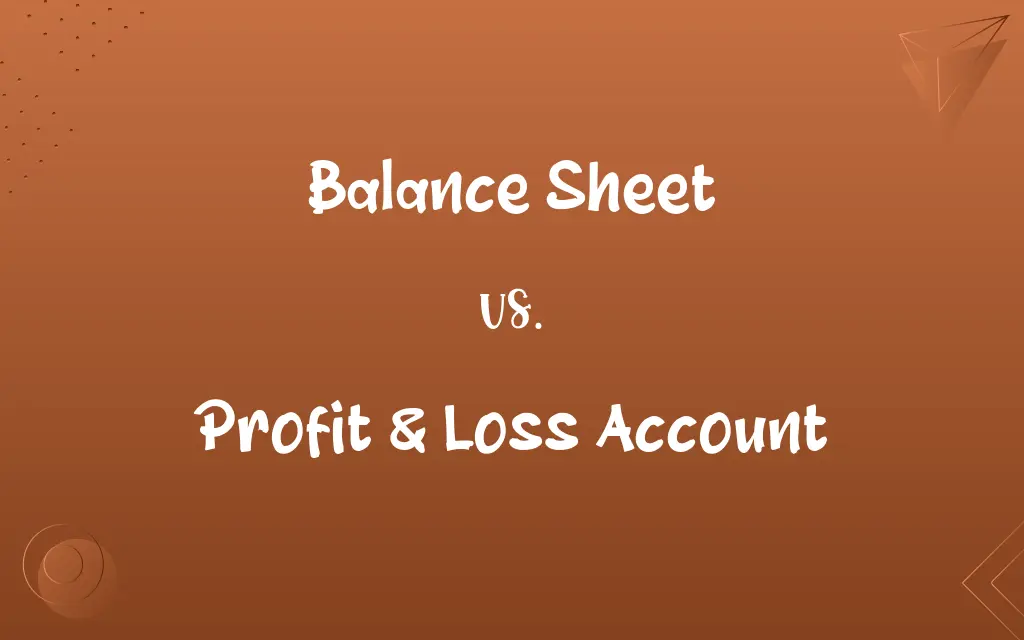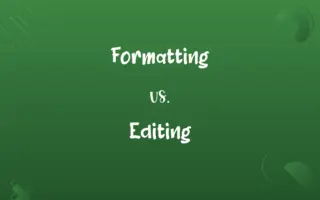Balance Sheet vs. Profit & Loss Account: Know the Difference

By Shumaila Saeed || Published on January 27, 2024
A Balance Sheet shows a company's assets, liabilities, and equity at a specific point in time, while a Profit & Loss Account (Income Statement) records revenues, expenses, and profits over a period of time.

Key Differences
The Balance Sheet and Profit & Loss Account are fundamental financial statements in accounting, serving different purposes. The Balance Sheet provides a snapshot of a company's financial position at a given moment, detailing assets, liabilities, and shareholders' equity. It reflects what the company owns and owes. On the other hand, the Profit & Loss Account, also known as the Income Statement, shows the company's financial performance over a specific period, usually a year or a quarter. It lists revenues and expenses, culminating in a net profit or loss, demonstrating how the company's operations contribute to its financial position.
Shumaila Saeed
Jan 27, 2024
Both the Balance Sheet and the Profit & Loss Account are interconnected and essential for stakeholders. The Balance Sheet's strength lies in presenting the company's financial stability and liquidity, showcasing how well it can meet its short and long-term obligations. Conversely, the Profit & Loss Account focuses on the company's operational efficiency, highlighting its ability to generate income and manage expenses. The net profit or loss from the Profit & Loss Account impacts the equity section of the Balance Sheet, linking the two statements.
Shumaila Saeed
Jan 27, 2024
The Balance Sheet and the Profit & Loss Account provide distinct but complementary views of a company's financial health. While the Balance Sheet is akin to a financial photograph taken at a specific point, the Profit & Loss Account is more like a movie, depicting the company's financial performance over time. The Balance Sheet's key components include assets (what the company owns), liabilities (what it owes), and shareholders' equity (the net worth). In contrast, the Profit & Loss Account encompasses revenue (income from sales or services), expenses (costs incurred in earning the revenue), and the resulting net profit or loss.
Shumaila Saeed
Jan 27, 2024
Understanding both the Balance Sheet and the Profit & Loss Account is crucial for a comprehensive view of a company's financial status. The Balance Sheet shows the result of the company's past decisions and current financial position, while the Profit & Loss Account reveals how effectively the company is running its day-to-day operations and generating profits. Together, they offer insights into a company's financial viability, profitability, and potential growth, which are vital for investors, creditors, and management.
Shumaila Saeed
Jan 27, 2024
In summary, the Balance Sheet and Profit & Loss Account serve different but equally important roles in financial reporting. The Balance Sheet's focus on assets, liabilities, and equity provides a static view of the company's financial standing at a particular point. In contrast, the Profit & Loss Account dynamically tracks the company's financial performance over a period, emphasizing its revenue-generating and expense-managing capabilities. Both are indispensable tools for assessing a company's overall financial health and making informed business decisions.
Shumaila Saeed
Jan 27, 2024
ADVERTISEMENT
Comparison Chart
Purpose
Shows company's financial position at a point in time
Reflects company's financial performance over a period
Shumaila Saeed
Jan 27, 2024
Content
Lists assets, liabilities, and equity
Summarizes revenues, expenses, and net profit or loss
Shumaila Saeed
Jan 27, 2024
Focus
Financial health and solvency
Operational efficiency and profitability
Shumaila Saeed
Jan 27, 2024
Users
Used by investors, creditors, and management
Primarily by management for decision-making
Shumaila Saeed
Jan 27, 2024
ADVERTISEMENT
Balance Sheet and Profit & Loss Account Definitions
Balance Sheet
Used to assess a company's ability to meet long-term obligations.
Creditors scrutinized the balance sheet to evaluate the company's solvency.
Shumaila Saeed
Jan 06, 2024
Profit & Loss Account
Summarizes revenues and expenses to show net profit or loss.
The profit & loss account highlighted a significant increase in net income.
Shumaila Saeed
Jan 06, 2024
Balance Sheet
Reveals a firm's financial standing at a particular date.
The balance sheet from December provided insight into the company's year-end financial position.
Shumaila Saeed
Jan 06, 2024
Profit & Loss Account
Tracks all operational income and costs.
The profit & loss account showed higher expenses than the previous quarter.
Shumaila Saeed
Jan 06, 2024
Balance Sheet
Offers a look at a company's capital allocation between debt and equity.
The balance sheet revealed a healthy balance between equity and debt.
Shumaila Saeed
Jan 06, 2024
ADVERTISEMENT
Profit & Loss Account
Demonstrates how effectively a company is generating profit.
A consistent positive trend in the profit & loss account indicated growing profitability.
Shumaila Saeed
Jan 06, 2024
Balance Sheet
It categorizes a company's resources, debts, and ownership equity.
Their balance sheet indicated more assets than liabilities.
Shumaila Saeed
Jan 06, 2024
Profit & Loss Account
Used for detailed analysis of company earnings.
Investors reviewed the profit & loss account to understand the earnings breakdown.
Shumaila Saeed
Jan 06, 2024
Balance Sheet
A balance sheet reflects a company's financial stability at a given time.
The balance sheet showed strong assets and reasonable liabilities.
Shumaila Saeed
Jan 06, 2024
Profit & Loss Account
Assesses management's efficiency in using resources.
The profit & loss account revealed efficient cost management.
Shumaila Saeed
Jan 06, 2024
Repeatedly Asked Queries
What is the key purpose of a Profit & Loss Account?
The primary purpose of a Profit & Loss Account is to reveal a company's ability to generate profit by managing revenues and expenses.
Shumaila Saeed
Jan 27, 2024
What is a Balance Sheet?
A Balance Sheet is a financial statement that shows a company's financial position, detailing assets, liabilities, and shareholders' equity at a specific point in time.
Shumaila Saeed
Jan 27, 2024
How do a Balance Sheet and a Profit & Loss Account differ?
A Balance Sheet presents the financial position as of a particular date, while a Profit & Loss Account shows the company’s financial performance over a period.
Shumaila Saeed
Jan 27, 2024
What is a Profit & Loss Account?
A Profit & Loss Account, also known as an income statement, is a financial report that shows a company's revenues, expenses, and profit or loss over a specific period.
Shumaila Saeed
Jan 27, 2024
How are expenses represented in a Profit & Loss Account?
Expenses in a Profit & Loss Account include all costs incurred to earn revenues, such as cost of goods sold, salaries, and rent.
Shumaila Saeed
Jan 27, 2024
What are liabilities in a Balance Sheet?
Liabilities are obligations the company owes to others, such as loans, accounts payable, and mortgages.
Shumaila Saeed
Jan 27, 2024
What role does shareholders’ equity play in a Balance Sheet?
Shareholders' equity represents the amount owners invested in the company plus retained earnings, indicating the net worth.
Shumaila Saeed
Jan 27, 2024
How does a Profit & Loss Account help in tax preparation?
It provides detailed information on taxable income, helping businesses accurately report earnings and calculate taxes due.
Shumaila Saeed
Jan 27, 2024
Do all businesses need a Balance Sheet and a Profit & Loss Account?
Yes, these financial statements are essential for all businesses to track financial health and meet regulatory requirements.
Shumaila Saeed
Jan 27, 2024
Why are Balance Sheets important?
Balance Sheets are crucial for understanding a company's financial stability, liquidity, and capital structure at a given moment.
Shumaila Saeed
Jan 27, 2024
What are assets on a Balance Sheet?
Assets on a Balance Sheet are resources owned by a company, like cash, inventory, and property, that have economic value.
Shumaila Saeed
Jan 27, 2024
What can a Profit & Loss Account indicate about a business's future?
It can show trends in revenues and expenses, helping forecast future profitability and guide business strategies.
Shumaila Saeed
Jan 27, 2024
What impact do sales have on both statements?
Sales increase assets on the Balance Sheet and revenues on the Profit & Loss Account, affecting both profitability and financial position.
Shumaila Saeed
Jan 27, 2024
What does the Profit & Loss Account show about a company’s revenues?
It details how the revenue is generated from business operations and other activities over the accounting period.
Shumaila Saeed
Jan 27, 2024
Can a Balance Sheet help in securing loans?
Yes, it provides lenders with insights into a company’s financial health, aiding in the decision-making process for loan approval.
Shumaila Saeed
Jan 27, 2024
Is it possible for a company to have a strong Balance Sheet but a weak Profit & Loss Account?
Yes, a company might have a solid financial position but may be struggling with profitability, as indicated by the Profit & Loss Account.
Shumaila Saeed
Jan 27, 2024
Can a Balance Sheet show company performance over time?
No, a Balance Sheet provides a snapshot at a specific date, not a performance over time, which is the role of a Profit & Loss Account.
Shumaila Saeed
Jan 27, 2024
How often should a Balance Sheet and Profit & Loss Account be prepared?
Typically, they are prepared annually, but can be done more frequently for internal management purposes.
Shumaila Saeed
Jan 27, 2024
Can a Balance Sheet change frequently?
Yes, since it reflects the company’s financial position at a specific point, it can change with every transaction.
Shumaila Saeed
Jan 27, 2024
How do investors use a Balance Sheet and Profit & Loss Account?
Investors use them to assess a company’s financial health, profitability, and potential for future growth.
Shumaila Saeed
Jan 27, 2024
Share this page
Link for your blog / website
HTML
Link to share via messenger
About Author
Written by
Shumaila SaeedShumaila Saeed, an expert content creator with 6 years of experience, specializes in distilling complex topics into easily digestible comparisons, shining a light on the nuances that both inform and educate readers with clarity and accuracy.






































































